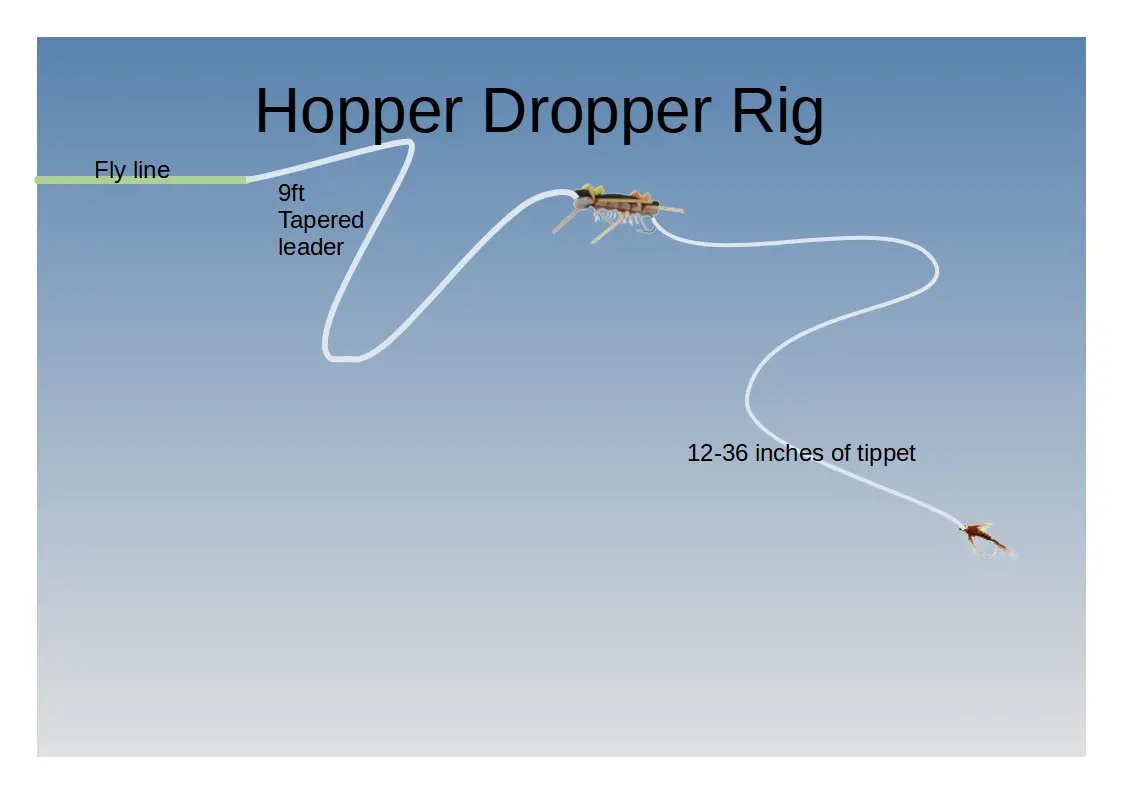The Hopper Dropper might just be my favorite summer time fly fishing rig. Simply because it catches more trout.
The Hopper Dropper Rig is a variation of the standard dry fly dropper rig. It uses a large terrestrial fly that resembles a Grasshopper, cicada, crickets, locus or adult stonefly, or any large terrestrial insect.
One of the main advantages of using a Hopper as the dry is that their large size can better suspend heavier nymphs so are less likely to be submerged in turbulent water.
Advantages of the Hopper Dropper Rig
The biggest advantage of the Hopper Dropper Rig is that the Hopper fly replaces the indicator.
I have had trout raise up and try to eat my indicator, so why not replace it with a fly?
A large hopper fly represents such a rich source of energy that it has the potential to attract trout in from a much greater area than a tiny nymph or dry fly.
Even if the trout decides not to take the Hopper, much of the time they will grab the nymph on their way back down. It is a very worthwhile reputation.
It simply catches more fish than a nymph and indicator combination.
Disadvantages of the Hopper Dropper Rig
The main disadvantage is that the Hopper Dropper Rig can be a pain to cast, doubly so in windy weather.
Unless you have some expert level casting ability, it is also not really possible to deeply fish nymphs. For ease of casting, the dropper nymph is nearly always only a foot or two below the dropper.
If the trout are feeding on nymphs down deep, an indicator will likely be a better option.
How to Tie a Hopper Dropper Rig?
I start with a 9ft leader that tails out into a 1X (0.010”) diameter line.
To help prolong the life of the leader, I usually attach a 1 foot section of 1 x or 2x monofilament to which I tie on my hopper dry fly of choice.
(The Hopper Dropper Rig is quite heavy, so it is important to have a sufficiently thick diameter leader to transfer enough momentum to the hopper to assist in turning it over).
I then tie my final section of tippet directly to the curve of the Hopper’s hook. Depending on the weight of my nymph I probably will use 4x or 5x tippet. I generally use 1 or 2 feet of tippet material.
The longer the tippet, the more difficult it becomes to cast, although it can allow for deeper presentations.
Best place to fish Hopper Dropper Rig
I nearly always fish a Hopper Dropper Rig in similar waters I will use an indicator.
I like to cast the Hopper Dropper Rig towards the head of pools and allow it to drift down current seams. It works particularly well when drifted around submerged logs, rocks or vegetation.
It is also a great option when fishing in faster more turbulent water. The large hopper generally has enough buoyancy to stay afloat.
On hot summer days, I sometimes even fish it around lake margins, although in most Stillwater situations I have better luck fishing a small black gnat or mayfly imitation rather than a hopper.
Best time to fish Hopper dropper rig
The hopper drop rig works best during the summer months when the trout have been feeding on large numbers of terrestrials.
I generally find it works best in the afternoon when there is plenty of insect activity and a slight breeze.
Which dry flies to use with the Hopper Dropper Rig
When fishing large terrestrials, I always like to bring several different patterns. I have found, that if a trout rejects the first presentation, or if I miss the strike. Chances are they will continue to ignore that pattern, but often changing to a slightly different pattern is enough to convince a trout to try again.
My favorite dry flies to use with the Hopper Dropper Rig include the Chernobyl Ant, rubber legged stimulator, or a deer hair Cicada pattern.
I like flies with rubber legs, maybe it is just my immigration, but I feel the long rubbery legs do tempt more trout to strike, plus they make the flies seem more natural. In my experience, they certainly do not hurt.
I also prefer deer hair Cicada patterns over foam. I feel that nicely trimmed deer hair looks better and traps air bubbles in such a way to result in a more natural presentation. Deer hair is also very buoyant. I do not see much need to use foam on such a bulky fly.
Which Size Dry Fly to use with the Hopper Dropper Rig
It is best to match the size of the dry to the size of the natural terrestrials in your area, but do not be afraid to go large.
When fishing terrestrial flies, I typically fish size 6 or 8 patterns. We get some very large natural cicadas where I typically fish, which can be several times larger than my flies. The trout do not seem to care much and will still raise to take a size 6.
The larger, and bulkier the fly the harder they become to cast. So I feel a size 6 is a good compromise. If I go much larger, I probably will need to use a heavier tippet to properly straighten out my presentation.
What type and size nymph to fish with the Hopper Dropper Rig
Again, I try to match the size of the insects in the water. I typically fish a weighted #12-#16. In some heavily pressured water, I might go down to a #18
The nymph pattern entirely depends on what is fishing well in the water, but I generally like to use a weighted nymph allowing it to sink faster. A couple of common general purpose examples will be a Phesant Tail nymph or a bead headed Hare Ear nymph.

